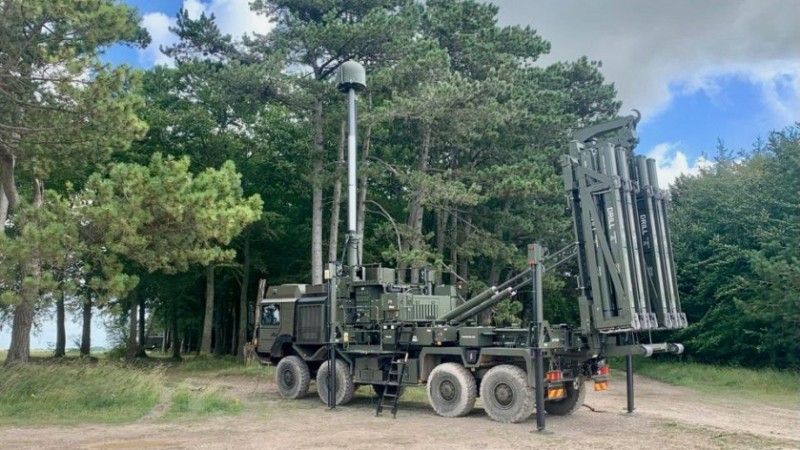Armed Forces
Narew SHORAD Still a Go [COMMENTARY]

The designation of the CAMM missile as the preferred choice in the Narew SHORAD programme, by the Armament Inspectorate of the Polish MoD, is an important milestone in this initiative. However, the above does not mean that the programme is finalized, as other options remain „on the table”. The bidders could potentially take steps to increase the attractiveness of their proposals.
Mariusz Błaszczak, head of the Polish MoD, during a joint press conference also involving his British counterpart (Ben Wallace), stated that the Armament Inspectorate recommended that further talks in the Narew programme refer to the CAMM system. These active radar-guided missiles are already being used by the Royal Navy, and the British Army. Extended range CAMM-ER variant is also being developed, offering 45 kilometers range. A memorandum of understanding was concluded on that matter with the British.
This would make it possible to launch in-depth negotiations on licensing and performance contracts. Nonetheless, it does not translate into the finalization of the Narew programme that bears a critical meaning for the Polish Armed Forces. One should remember that the implementation phase related to the Narew system (SHORAD) was launched in April last year. It follows a 7-years long analytical/conceptual phase. It was in September this year. during the MSPO event in Kielce, when a framework agreement was signed concerning the system in question.
The PGZ Group is the primary contractor that would also be involved in agreements referring to the individual elements of the system, missiles included. Only components tied to Wisła-Narew integration via the IBCS would be subjected to G2G agreements with the US Government, within the framework of the FMS scheme. According to the assumptions of the framework agreement, the Polish Ministry of Defence, and the PGZ Group would be contracting the individual elements of the Narew system separately, diminishing the risk of delays. The missile, since technology is to be transferred by an external partner and then implemented in the Polish industry, is the most challenging element of the programme.
The current declaration made by the MoD is a step taken towards the creation of the Narew system around the CAMM missile, or the family of CAMM missiles (including the CAMM-ER effector). It is, however, too early to judge. The licensing and performance contracts are about to be signed, with details being subject to negotiation, according to statements made by Minister Błaszczak. The political involvement of the UK in the deterrence initiative targeting Russia is an advantage of the British offer. This may mean that a closer alliance is established, with troops being deployed to the border, or defence cooperation being established with Ukraine. British offer in the Miecznik programme is also broadly marketed in Poland.
Talks similar to the planned ones, concerning Narew, entail some uncertainty. One needs to agree on the schedule, cost, and scope of the ToT, and the related responsibility, financial liability also counts. Challenges may occur here. This has been well exemplified by the course of events tied to the offset commitments in the Wisła air defence programme. Thus, it is too early to speak of the final selection of the missile.
One may expect, following the declaration made by the MoD, that the remaining bidders would be willing to make their proposals far more attractive. One knows that Raytheon/Kongsberg NASAMS (Sidewinder/AMRAAM combo, with AMRAAM-ER, also included) was also offered in Narew, alongside CAMM. Raytheon's proposal has recently been selected by Qatar, Hungary, and Australia. The Norwegian-American team also placed several optional offers, including accelerated delivery of systems in ready-to-use configuration, or even IBCS-integration of the effectors. Noteworthy, modified Sidewinders would also work with this system, within the framework of the IFPC solution developed in the US. The list of contractors includes the Dynetics company. Offers were also placed by Israeli companies - Rafael with its Spyder system (I-Derby and Python-5), and IAI, with Barak-MX.
One cannot rule out that the aforesaid entities will be making attempts to make the PGZ Group and the MoD interested in their products, new procurement conditions (Transfer of Technology, cooperation, also outside the Narew programme), or even price. The price also refers to the transfer of know-how specifically, as this may have a relevant impact on the shape of the Narew contract.
Narew system consists of 23 air defence batteries - a single fire unit for all of the system may consist of more than 1,000 missiles. Acquisition of missiles, and the whole system may have a decisive impact on the future of the Polish military, and domestic defence industry, over the upcoming several years. The programme is said to have a potential value of 30 to 60 bn zlotys. The deliveries would last until around 2035. These things mean that the system would be active in the second half of the next century, while the lifecycle cost may exceed the procurement pricetag. One may conclude then, that Narew is the most significant and the most convoluted undertaking in history, involving the Polish defence industry and the foreign partners.
The Narew SHORAD programme bears the key and fundamental meaning for the Polish Armed Forces. This system would protect both the land forces, as well as important infrastructure, such as airbases. Without a SHORAD system, the other layers of air defence network would lack effectiveness, with air threats becoming far more serious. The recent release on the indication of the CAMM missile brings us one step closer to the completion of the Narew programme. If successful, all agreements would be signed by 2023, and the first launch of the joint air defence task force would take place in 2026. One cannot be certain whether this solution would be chosen though.

dim
"Podjęliśmy decyzję, że podejmiemy, w przyszłości, decyzję".